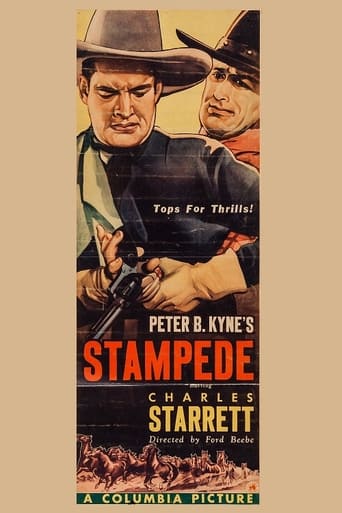JohnHowardReid
Charles Starrett (Larry Carson), Finis Barton (Dale Milford), J.P. McGowan (Stevens), LeStrange Millman (Milford), James McGrath (Brooks), Reginald Hincks (sheriff), Arthur Kerr (Gans), Jack Atkinson (Hodge), Michael Heppell (Kyle), Ted Mapes.Director: FORD BEEBE. Screenplay: Robert Watson. Allegedly based on an original screen story by Peter B. Kyne (but actually an original screen story by Ford Beebe). Photography: George Meehan, William Beckway. Film editor: William Austin. RCA Sound System. Producer: Peter B. Kyne. A Peter B. Kyne Production.Copyright 6 June 1936 by Columbia Pictures Corp. of California, Ltd. No New York opening. U.S. release: 27 November 1936. 6 reels. 58 minutes.NOTES: The 6th of Starrett's 132 starring "B" westerns. COMMENT: One of Beebe's better films, "Stampede" was produced on a top "B" budget, allowing the director room not only to incorporate some splendidly staged action scenes, but to invest the picture with atmosphere and class. Locations are most effectively utilized and sound effects are highly realistic.Starrett plays the avenging hero with both freshness and vigor, whilst the villains are headed by none other than J.P. McGowan, one of the best action directors in the business. Whether he assisted Beebe on the other side of the cameras here is open to question, but certainly he gives the film's strongest performance in what is undoubtedly an extremely solid cast. James McGrath is also a stand-out as the seedy Brooks. Writer/Director Ford Beebe cleverly delays Starrett's entrance, thus building up tension. And as for why Beebe's excellent script is attributed to Peter B. Kyne, I guess it was thought that Kyne would bring in the customers.
classicsoncall
It's always a treat for me to see Charles Starrett in a non Durango Kid role; "Stampede" was made about four years before the first film in that series. It certainly differs from the Durango formula. There's no comedic sidekick, in fact, the entire picture is done fairly straight as a dramatic Western. Starrett's character is out to purchase the Milford Stock Ranch in Salt Springs, Montana, but opposing forces will commit murder and mayhem to prevent that from happening. It will be up to Larry Carson (Starrett) to sort things out and bring the bad guys to justice.Also unlike the Durango films, there's a love interest for Starrett's character, though it doesn't start out that way when Carson learns his brother's been murdered. Villain Matt Stevens (J.P. McGowan) is pulling strings behind the scenes to make it look like the owner of the Milford Ranch is the murderer. It takes pretty Dale Milford (Finis Barton) some time to trust in Carson, and together they manage to get the goods on Stevens, even as he's using renegade Milford hands to do some of his dirty work. The way they set up Stevens to open his personal safe was so simple it was ingenious; bringing his notes and papers out into the open to prove his guilt with the evidence.In the film, Starrett wears all black, except for a white hat and bandanna. Watching the film, it occurred to me how gorgeous the trail footage was, something you generally don't get a hint of in a 'B' Western. A fair amount of time is spent by riders on horseback between ranches and town, and the scenery definitely stands out.One confusing plot point in the story centers on Henry Brooks (James McGrath), who's character owns a hotel and is in the pocket of bad guy Stevens. It seemed like he was the guy who was going to foreclose on the Milford Ranch, but that didn't seem to make much sense to me. It would have been better to cast him as the crooked town bank president, and that would have solved the issue.It shouldn't come as a surprise that the title "Stampede" really has little to do with the story involved. In fact, there wasn't even a hint of a stampede to speak of, unless you consider Stevens' henchmen driving the Milford horses through a pass that he was going to dynamite. That tactic proved rather ineffective, since it did nothing to delay Carson's progress in getting to the truth.Chronologically, the story start to finish might have covered a period of only twenty four to forty eight hours, but that didn't stop Carson and Dale from making wedding plans. I'm just not sure how romantic a honeymoon they might have had; it was going to be spent driving a herd of horses to Salt Springs!
Steve Haynie
Stampede features Charles Starrett before he did the Durango Kid series. Reading Les Adams' plot summary, I discovered that Stampede was filmed in Canada. Perhaps that is why the story is supposed to take place in Montana. The outdoor scenery is beautiful.Charles Starrett was a good actor, but some of the later Durango Kid movies were so cheaply made that they spoiled any talent on the screen. With its typical western plot, Stampede was well done within the context of B movies. At times the movie does not look cheap, and the cast was excellent. Starrett played a few scenes with a seriousness that I have not seen in other western heroes. At other times the movie feels like it was on a budget. As the story reaches its climax the movie feels a little more like a standard issue western. It was, but it tried not to be.There was little to complain about, but I feel that the ending left at least one loose end. One of the conspirators, Brooks, did not get his punishment at the end. He was just left out of the action. We just "know" he was found out and treated accordingly. Apparently the rule about the townsman in the suit going to jail at the end wasn't written in stone yet, and it was already 1936!

